The Greek cuisine is recognized as being one of the tastiest and healthiest in the world. But you’ll need this guide on how to order Greek food to make the most of it!

Greek Food Guide
For many tourists, ordering food in Greece can be a very complicated affair. While many dishes like souvlaki, moussaka and tiropita are very well known, there are dozens others that will puzzle even the most loyal visitors.

Here is an extensive article on the food of Greece. It includes 50 of our most popular dishes, that you are bound to come across in many restaurants in Greece.
To help you further, here is my local’s guide to ordering Greek food. Includes what to do if you have allergies, or if you are following a specific diet, such as a gluten free diet. Enjoy!
A Local’s Guide to Ordering Greek Food
The first thing you need to know about Greek food is that, unless you are at an upscale restaurant, sharing all your dishes, including your main course, is absolutely fine. The strict protocol followed in some other countries does not exist in Greece.
In fact, dishes are meant to be shared, and the more people around the table, the merrier. Food always tastes better with company!
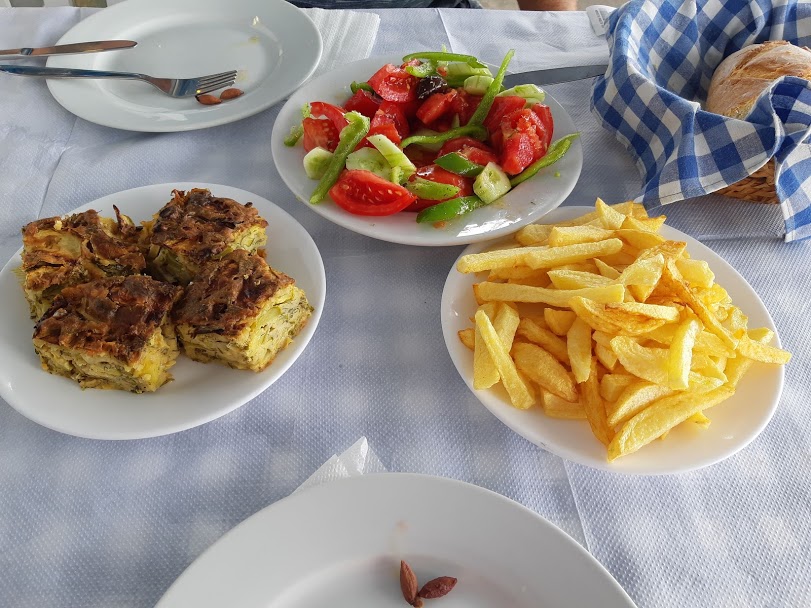
The only exceptions that I can think of are the famous meat skewers and pita wraps – souvlaki and gyros pita. These aren’t really meant to be shared. That said, no one will care if you try a bite of your friend’s meal.
What does a Greek Menu look like?
This is a great question. Menus in Greek restaurants can vary a lot between them, and generally depend on the type of restaurant you are visiting.
Have a look at this guide to Greek food culture. I’ve included the main types of Greek restaurants you are likely to come across when in Greece.
As an example, a souvlatzidiko, a taverna and an ouzeri will have radically different menus. Still, they will all typically offer the same 10-15 staples, such as a Greek salad and fries.
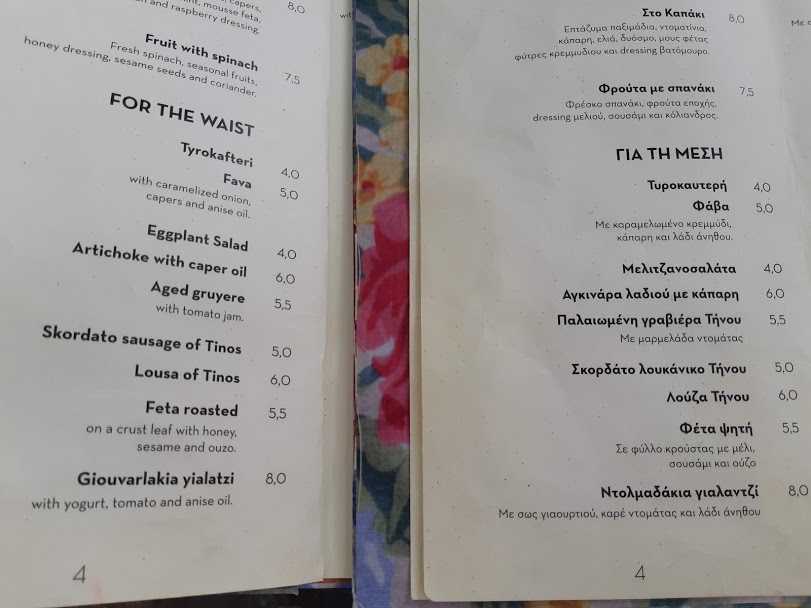
It doesn’t always help that some of the translations in English are unhelpful, puzzling, or just plain funny. Check out “for the waist” above – can you guess what it means??
(Loose translation: To share!)
How to order food at a Greek souvlatzidiko
A popular choice is to eat at a souvlatzidiko, also called psistaria or psitopolio. This place specializes in grilled meat, served either on a plate or inside a pita.
A souvlatzidiko is a good option if you want a quick and filling meal, if you are on a budget, and if you are travelling with children.
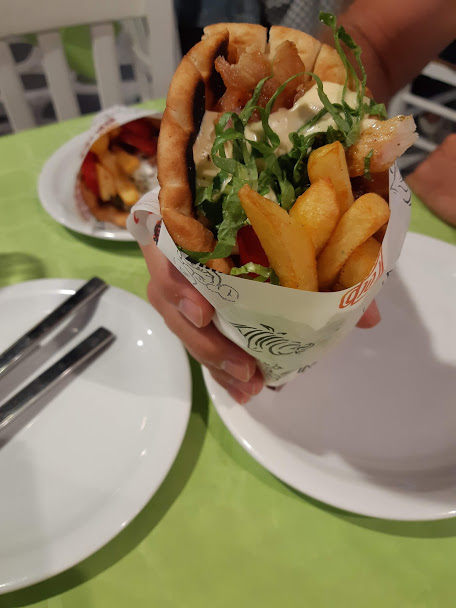
The best known choices are gyros, which can be described as meat carvings, and souvlaki, which is composed of bite-sized pieces of meat on a stick. These are usually made from pork or chicken, while beef and lamb are less common.
Perhaps the most popular option among Greeks, and definitely the most filling one, is a wrapped pitogyro. Here, the gyros meat goes inside a pita, along with fries, onions, tzatziki garlic sauce and a few pieces of tomato.
If you prefer to share, you can get a portion of gyros meat, which also includes fries, pita and some salad.

If you want something slightly lighter, go for souvlaki, the meat on a stick. You can either have one / two pieces, or order a plate, which includes 3-4 skewers along with fries, salad and some pita bread.

By definition, a souvlatzidiko doesn’t cater for vegetarians and vegans. However, you can get a pita stuffed with fries and salad, or just any of the salads on the menu. A bigger souvlatzidiko may have a selection of starters, so check if any of them are vegan.
How to order food at a Greek taverna
Apart from a souvlatzidiko, the type of restaurant you are most likely to find while travelling around Greece is the good old taverna. This type of restaurant generally offers a long selection of dishes to suit everyone’s taste.
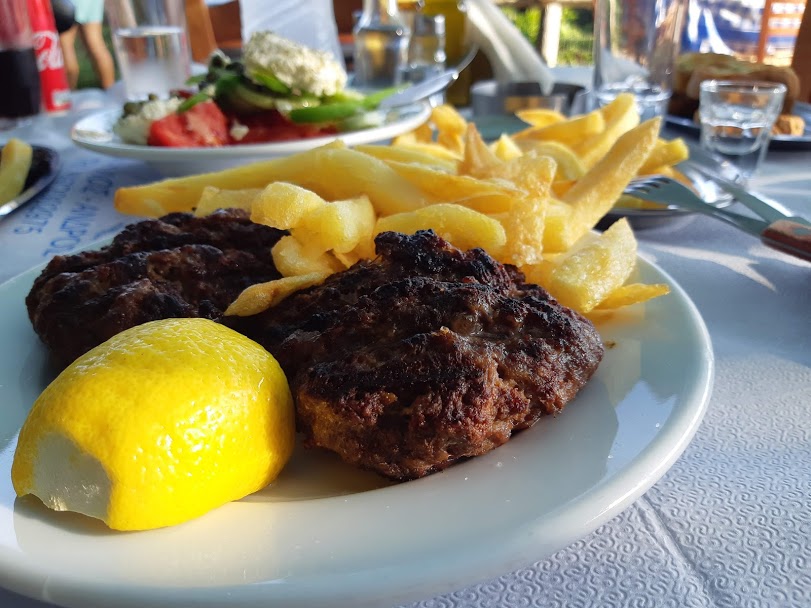
Tavernas typically serve up a few simple dishes, such as grilled meats and salads, but also a few more regional or complex dishes. A Greek taverna is a great option if you are feeling adventurous and want to try something new.
Starters and salads often take up a large part of the menu. It’s perfectly fine to just order a selection of starters and not worry about a main course.
What to eat at a Greek taverna
Most Greek taverna menus would typically include the following sections:
– salads, such as a Greek salad (which we call ‘village salad’), horta (boiled greens), dakos, boiled vegetables, cabbage-carrot, lettuce and the taverna’s special
– a selection of starters, which can range from 4-5 starters to well over 30. Some of the most common starters are fava (mashed yellow split peas), dolmadakia (grape leaves stuffed with rice), cheesepie, fried courgette balls, spicy cheese salad, eggplant salad, and giant beans.
– charcoal grilled meats such as steaks, sausage, kokoretsi and chicken
– a few meat dishes which have been slow-cooked in the oven or a pot, such as rooster in wine sauce, rabbit with small onions, lamb roasted with potatoes, or the more unusual tripe soup
– specialty dishes, like moussaka, layers of fried potatoes and eggplants, along with ground beef and a bechamel sauce (flour, milk, butter and egg sauce)
– some meatless main courses containing vegetables, grains and possibly pulses, known in Greek as “ladera” (cooked in oil). These dishes are suitable for vegetarians and vegans, as they follow the Greek fasting tradition. Among the most popular ones are stuffed tomatoes and peppers, peas, okra, chickpea stew, and eggplants with cheese.
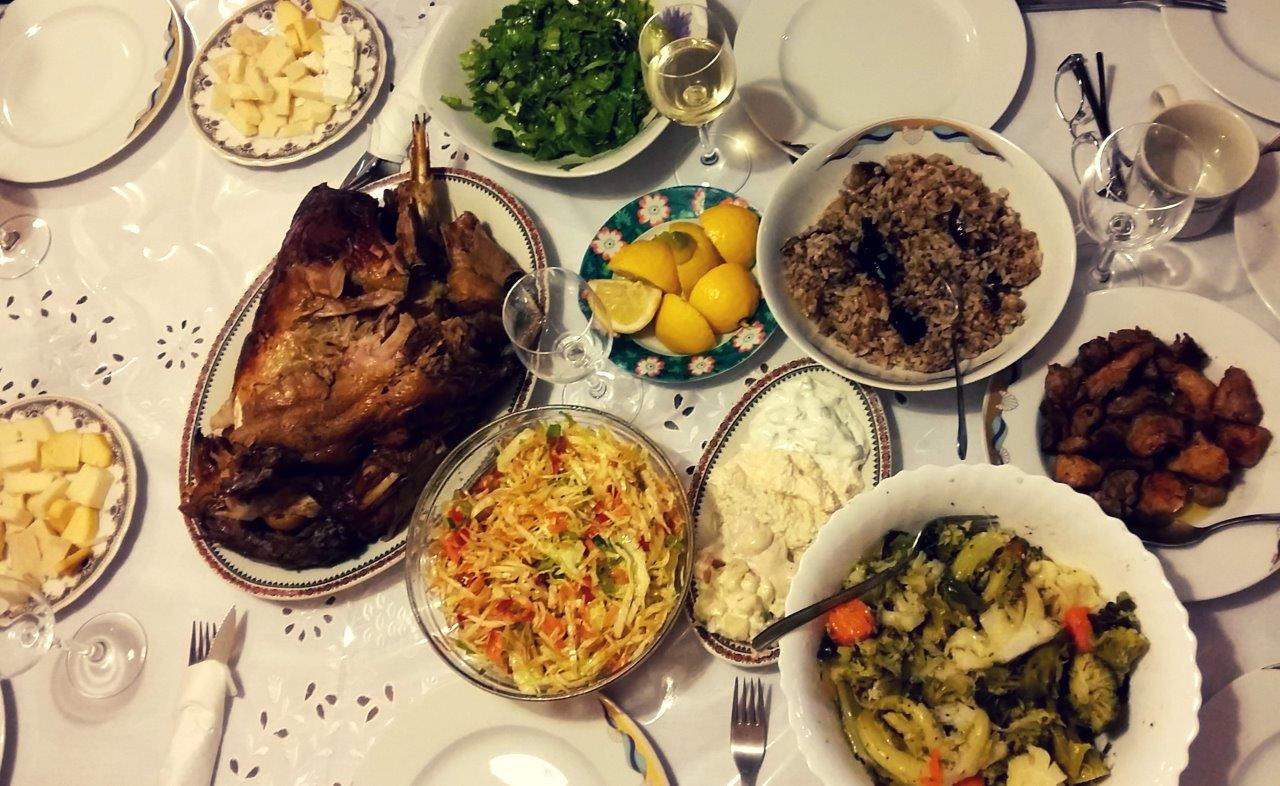
All this is served with fresh Greek bread which you can use to mop up the lovely sauces and the extra virgin olive oil in your Greek salad.
Here’s a more in-depth article about the traditional Greek taverna. And if all these foods are Greek to you, check out this article which describes 50 of the most popular Greek dishes in detail!
The fish taverna
Just a sidenote – a psarotaverna specializes in fish dishes, but they would typically offer a few meat dishes to suit people who are not keen on fish. This is the best place to try fresh fish and seafood.
Note that fresh fish, which is served by the kilo, can be quite expensive. For example, the red mullet might cost around 60-70 euros per kilo.
When in doubt, go for the delicious grilled sardines – this small, tasty inexpensive fish is my favorite dish – and it’s super rich in omega-3s. Another delicacy is maridaki or gavros, small, deep fried fish, served with lots of lemon.
Ordering Greek food in a mezedopolio, an ouzeri or a rakadiko
If you are a frequent visitor to Greece, you will definitely have noticed the locals sharing tiny plates in tiny restaurants with tiny tables and tiny wine glasses. In my opinion, this is where you can have some of the most inspired and unique Greek food.
The most common of these places are called mezedopolio, ouzeri and rakadiko. Here, the food on the table is meant to be shared, along with some alcohol. This is my favorite type of Greek restaurant, even without the alcohol!

The emphasis in a mezedopolio is mostly on the mezedes, the small dishes. An ouzeri and a rakadiko focus on ouzo and raki respectively. Here, the food is really meant to accompany the strong alcoholic drink. As such it has to be tasty and inspiring, in order for you to order the next round of drinks.
All these types of places will have menus with semi-obscure dishes, though if you visit Greece often you may recognize some of them. You may find a tiropita, but you may also find marinated fish, glistrida greens, octopus, sausages and fried liver.
There will typically be some form of saganaki, deep fried cheese, and loukaniko, sausage. You are also bound to find tigania, small pieces of pork cooked in a white / red wine sauce, and keftedes, deep fried meatballs.

If the description on the menu is not adequate, just ask your waiter. As for ouzo and raki – find out more about them in this article on Greek drinks!
The non-Greek option – Ethnic food in Greece
If you’ve had several days of souvlaki, Greek salads, tiropita, fish, dolmadakia and horta, you may actually want a break from all that Greek food. I can relate, as I love Thai and Indian food.
Generally speaking, ethnic food in Greece is not as big as in other European countries. Athens is the best place for ethnic food in Greece, and you can find some Indian and a few Thai restaurants.
Chinese restaurants used to be a big thing in the 1990s, but nowadays there aren’t so many of them. Sushi lovers will probably get disappointed in Athens, but there are a few options if you are really craving sushi and sashimi.
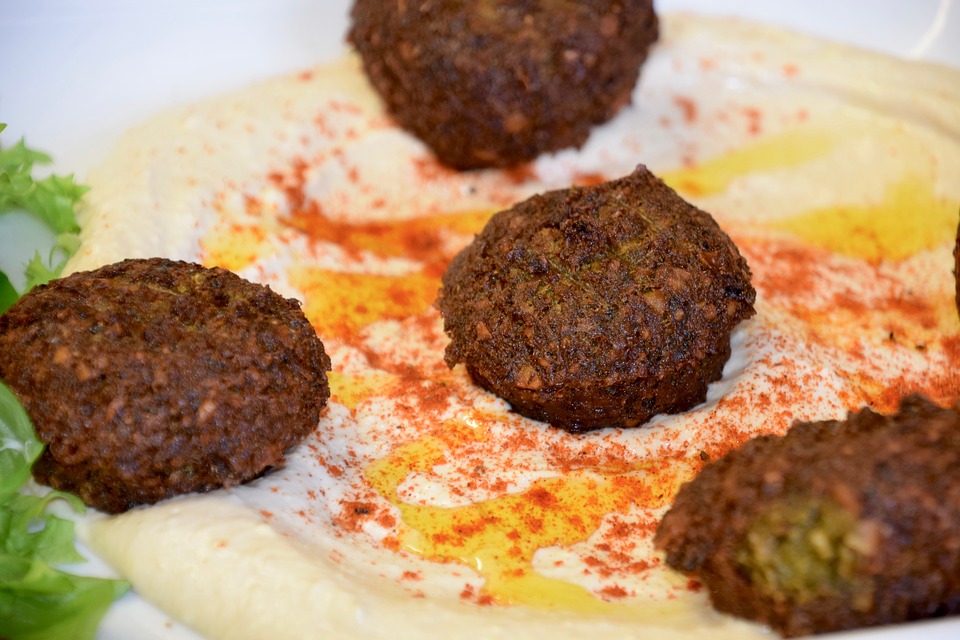
I have found a couple of Asian restaurants I like. Regardless, I have come to the conclusion that the quality isn’t as good as I had hoped for. Also, prices are steeper than in other countries in Europe, as Asian food still seems to be some kind of novelty.
Mediterranean cuisine in Greece
Athens also has a few down-to-earth eateries serving Mediterranean cuisines, such as Lebanese and Egyptian. Many of these are run by people who moved here, and they are located out of the touristy areas of Athens. Comment below if you are interested and I’ll provide some more information.
Some of the most touristy islands, especially those popular with specific nationalities, have ethnic restaurants that get good reviews. If you go off the beaten track though, don’t expect a lot more than the old, trusted taverna and souvlatzidiko.
Finally, as far as Italian food is concerned, there are pizza and pasta places pretty much everywhere. However, the food they offer is generally quite far from the Italian food I’ve had in Italy.
In a way though, pizza and pasta has been around for so long, that it’s not really considered ethnic food. You may even find that the taverna you went to have their own version of a pizza.
In general, I don’t think that ethnic food is Greece’s strongest point. If you are craving a good curry, by all means try your luck, and let me know where you went and what you thought!
Vegetarians and vegans in Greece
Like mentioned earlier, vegetarians and vegans won’t have any problems finding something to eat in Greece. Compared to other countries in Europe, dedicated vegetarian and vegan restaurants are rather scarce.
Yet, most restaurants will have a few dishes that are suitable for vegetarians and vegans.
Apart from the tasty tiropita and spanakopita, that contain cheese and eggs, vegetarians can have the strapatsada tomato omelette, all sorts of regional cheeses, most salads and starters, and every fried vegetable or fried vegetable ball on the menu.

Vegans on the other hand, can enjoy the numerous ladera dishes, where the main ingredients are olive oil, onion, tomato sauce, vegetables, pulses, legumes and grains. Ask the waiter for the dish of the day.
Many of our starters and most salads are also ideal. Your waiter will be happy to prepare your salad without some of the ingredients on the menu, such as cheese or meat.
How to order in Greece if I have an allergy to certain foods?
This is a very important issue for some people, and understandably so. No-one would like to have a severe allergy reaction, especially when travelling to a foreign country.
Your safest bet here is to inform your waiter, while also getting the simplest options in a menu, where you can control the ingredients. Most salads and grilled steaks / other meats would be fine. Just make sure that the salad doesn’t contain croutons or walnuts.
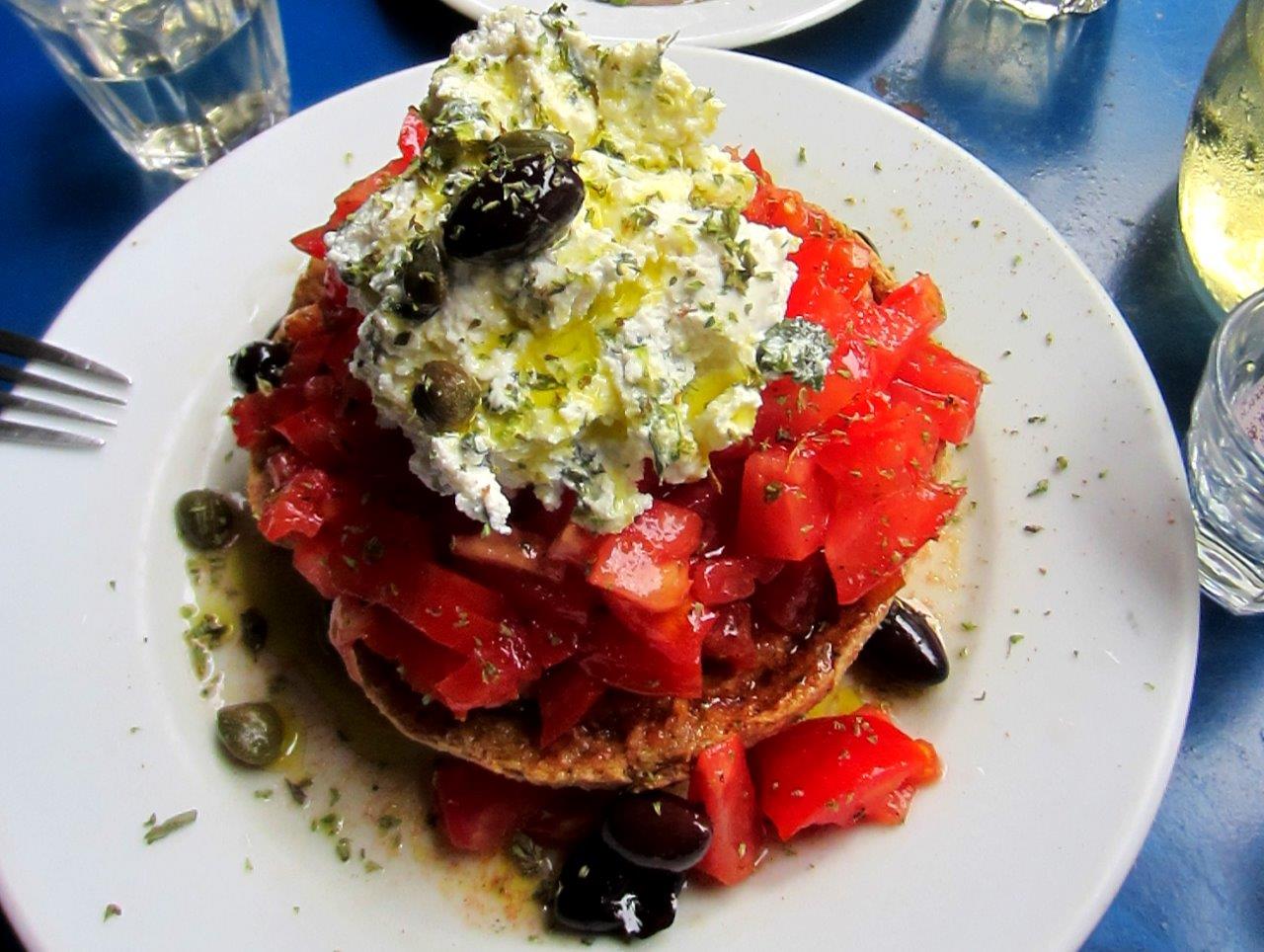
Most waiters will speak at least some English, and they will probably have encountered this issue before. However, I know very well how difficult it is to travel with a food allergy.
I have composed three texts for you, which you can print out, or simply bring up on your mobile phone, and show to your waiter. At the same time, make sure you carry your epipen with you at all times!
I am allergic to gluten – I’m following a gluten-free diet
Attention please – I am allergic to gluten! This means that I cannot eat any food that contains flour, wheat, barley, rye, oats, or other grains that contain gluten. I am not allowed to eat bread, rusks, cookies, cakes, pita bread, koulouri, fyllo dough.
I am also not allowed to eat any foods that contain flour as a sauce thickener, béchamel, or food that has been fried in a crust which contains flour.
Please note that I cannot eat food that has been grilled on the same grill with bread or pita bread, due to cross-contamination issues. Even a tiny amount of gluten can cause me serious issues. Thank you!

I am allergic to gluten – in Greek
Προσοχή παρακαλώ – έχω αλλεργία στη γλουτένη! Αυτό σημαίνει ότι δεν μπορώ να φάω οποιοδήποτε φαγητό περιέχει αλεύρι, σιτάρι, κριθάρη, σίκαλη, βρώμη, ή άλλα δημητριακά που περιέχουν γλουτένη.
Απαγορεύεται να φάω ψωμί, παξιμάδια, μπισκότα, κουλούρια, κέικ, πίτα για σουβλάκι, τυρόπιτα, σπανακόπιτα, και κάθε άλλη πίτα με φύλλο ή ζύμη. Απαγορεύεται επίσης να φάω φαγητά με σάλτσα που περιέχει αλεύρι, μπεσαμέλ, ή τηγανητά φαγητά που περιέχουν κουρκούτι με αλεύρι, όπως κεφτέδες, κολοκυθοκεφτέδες κτλ.
Προσοχή – δεν μπορώ να φάω φαγητό που έχει ψηθεί στην ίδια σχάρα με ψωμί ή πίτα, διότι ακόμη και ελάχιστη γλουτένη μπορεί να μου προκαλέσει τεράστια προβλήματα. Σας ευχαριστώ!
I am allergic to nuts
Attention please – I am allergic to nuts! This means that I cannot eat almonds, peanuts, pistachio nuts, walnuts, chestnuts, hazelnuts, pine nuts and any other nuts.
I am not allowed to eat foods or desserts that may contain them, such as multi-seeded bread, stuffed tomatoes and peppers, stuffed vine leaves, walnut pie, halva, cakes, and any other food or dish that may contain nuts. Thank you!

I am allergic to nuts – In Greek
Προσοχή παρακαλώ – Έχω αλλεργία στους ξηρούς καρπούς! Αυτό σημαίνει ότι δεν μπορώ να φάω αμύγδαλα, φυστίκια, φυστίκα Αιγίνης, καρύδια, κάστανα, φουντούκια, κουκουνάρια, και οποιονδήποτε άλλο ξηρό καρπό.
Απαγορεύεται να φάω φαγητά ή γλυκά που ενδέχεται να τους περιέχουν, όπως πολύσπορο ψωμί, γεμιστά, ντολμαδάκια, καρυδόπιτα, χαλβά, κέικ, και οποιαδήποτε άλλη τροφή που περιέχει ξηρούς καρπούς. Σας ευχαριστώ!
I am allergic to sesame seeds
Attention please – I am allergic to sesame seeds! This means that I cannot eat sesame seeds and tahini paste, as well as any food or dessert that contains them, such as bread, crispy bread sticks, koulouri, cookies, cakes, halva, sesame snap bars, falafel, hummus. Thank you!

I am allergic to sesame seeds – In Greek
Προσοχή παρακαλώ – Έχω αλλεργία στο σουσάμι! Αυτό σημαίνει ότι δεν μπορώ να φάω σουσάμι και ταχίνι, και οποιοδήποτε φαγητό ή γλυκό που τα περιέχει, όπως ψωμί, κριτσίνια, κουλούρι, κέικ, χαλβά, παστέλι, φαλάφελ, χούμους. Σας ευχαριστώ!
I am allergic to shellfish
Attention please – I am allergic to shellfish. This includes all crustaceans and mollusks, like shrimps, prawns, crabs, mussels and lobsters. This also includes dishes with a shellfish flavoring base, broth, or sauce.
I am allergic to shellfish – In Greek
Προσοχή παρακαλώ – Έχω αλλεργία στα θαλασσινά! Αυτό περιλαμβάνει όλα τα οστρακοειδή, καρκινοειδή και μαλάκια, όπως γαρίδες, καραβίδες, καβούρια, μύδια και αστακούς. Επίσης, περιλαμβάνει πιάτα που περιέχουν βάση, ζωμό ή σάλτσα με γεύση από οστρακοειδή. Σας ευχαριστώ!
Last, but not least – how to pay the bill in Greece!
After you’ve had your meal, it’s time for the bill! Once you’ve asked for the bill, don’t be surprised if you get a dessert or some fruit, and possibly a drink.
This is a small treat, courtesy of the restaurant, and it is fairly common in many areas of Greece, especially in less touristy areas.
In my experience, Crete is the best, as it’s very unlikely that you won’t get a treat. I still remember that one time we didn’t get one!

When it comes to actually paying the bill, you should be able to pay by card if you prefer. Keep in mind that most businesses, especially smaller ones, would definitely prefer cash.
Visitors, especially people from the US, often ask if they should leave a tip and how much it should be. Though Greeks don’t tip as a standard percentage of the bill, it is common to leave a couple of euros at a taverna. Larger groups could consider leaving a 5% – 10% of the bill.
There is nothing wrong with tipping more, rather than less, especially if you were happy with the meal and the service. Think of it as a nice gesture towards the waiter!
Here’s my full guide on tipping in Greece.
Frequently asked questions about Greek food
Here are some questions that visitors often ask:
Is Greek food healthy?
Traditional Greek food, and the Mediterranean cuisine in general, is considered to be one of the healthiest in the world. However, it really depends on what you order, as some dishes are a lot healthier than others. There are plenty of dishes based on vegetables, pulses or fish that you could order.
Is Greek food spicy?
Generally speaking, Greek food isn’t spicy. There are a few exceptions though – you could order tirokafteri, a spicy cheese dip, or deep fried spicy peppers, if you can find them.
What time is lunch in Greece?
Greeks tend to have lunch later than other Europeans, maybe at 14.00 – 14.30. Don’t worry though – you can order lunch a lot earlier than that. Many tavernas will serve lunch from 11.00 – 12.00 onwards.
What time is dinner in Greece?
Again, dinner in Greece seems to be later than in other European countries. Many Greeks won’t go out for dinner before 21.00 – 21.30. However, visitors can order dinner at any time they feel hungry.
Do I tip in Greece?
I’ll put it simply – no waiter will say no to a tip. Unless you’ve been extremely unhappy with your meal, please leave a good tip. There is no set amount for a tip in Greece, but a couple of euros is appropriate for two people visiting a basic taverna. Larger groups could consider leaving a 5% – 10% of the bill.
More Greece travel guides
I hope you’ve enjoyed this guide on how to order food in Greece. Interested in Greece and the Greek culture? Have a look at these other articles:
- Greek coffee culture
- How to take the metro in Athens
- Ideas for great souvenirs from Greece
- What to pack for Greece for all seasons
- 12 reasons to visit Athens
- Simple Greek words and phrases
- How to swear in Greek

Hi! I am Vanessa from Athens, and I love helping people find out more about Greece. I grew up among two grandmothers who loved cooking. My mom took up some of their best recipes and made them even better! While I love international cuisine (especially Asian dishes), I really think that the food of Greece rates very, very highly. If you have any questions, leave them right below.
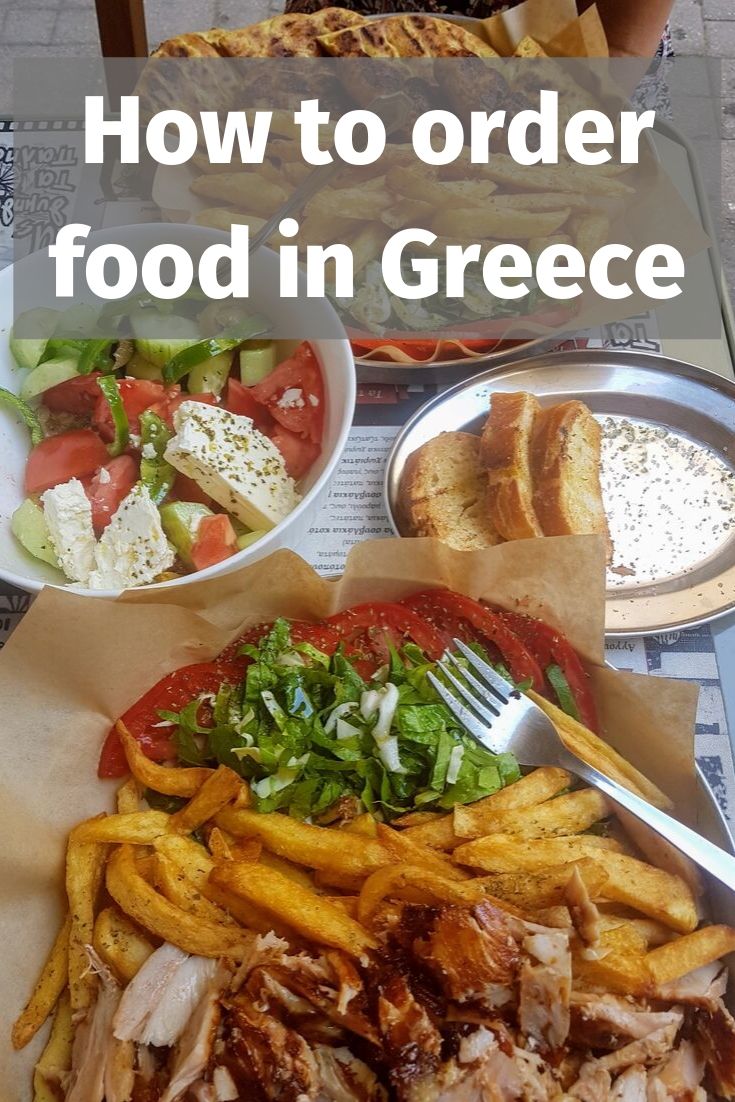

Oats don’t contain gluten unless contaminated.
Thanks for your comment – you are absolutely right! However, bakeries and other businesses that we have asked in Athens cannot always guarantee that their oats have not been cross-contaminated. For celiacs, even the slightest amount of gluten could cause troubles, so to be on the safe side we have included oats in our text. If you go to stores selling organic food, you will definitely find certified gluten-free oats.
As you mentioned, a souvatzidiko seems like a great option for a family on a budget. We are hoping to travel to Greece when we can travel again. I wonder if there is a Greek restaurant near by where we can test this out before we travel there.
I hope you can find one! There are many recipes on-line that you could try as well?
Thank you so much for such a brilliant guide!! This explains a lot of the small things and nuances that we’ve already encountered. I want to learn more so I can order more properly according to the locals 🙂
You are welcome! 🙂
Your guides are so great! Thank you for putting in all of the effort. I am visiting Greece soon and was wondering if you could help me put together what to say for a lactose allergy. I want to specify that goat and sheep are okay, but no cow. Thank you for your help!
Thanks for your question! REAL feta does not contain cow’s milk, but some restaurants might use other white cheeses instead. The phrase you should use is “I can have cheese / yoghurt made out of goat or sheep milk, but I have an allergy to cow milk and products containing it, such as tzatziki, saganaki or cheesepie- Μπορώ να φάω τυρί / γιαούρτι από γάλα πρόβειο ή κατσικίσιο, αλλά έχω αλλεργία σε προϊόντα που περιέχουν γάλα αγελάδας, όπως για παράδειγμα τζατζίκι, σαγανάκι ή τυρόπιτα”. If in doubt, it’s best to skip dishes containing dairy altogether, (or perhaps make sure you have lactase tablets with you)? Hope this helps, but feel free to get back to me with more questions as I will then update the article!
Getting ready to come to Greece for the first time. This is exactly the kind of information that I always look for but can’t always find about a new place. I have a feeling that your website might just be my new best friend. Thanks!
I find often “vegan” is a word that is not readily understood. If you’d like to order vegan food you can ask for νηστίσιμο “nee-STEE-see-mo” (Lenten Fasting), Χωρίς ψάρια “Horees Psareeah” (without fish) – and that communicates the same meaning quite nicely. (it does not rule out honey)
Taking our 14 year old granddaughter to Greece in June 2023. She is a super picky eater. Will not eat any fruits or nuts. Is averse to even trying anything new. She said she will basically order hamburger with fries everywhere. She does love cheese, so that is a plus.
Any helpful hints for us?
Hi Cathy – sounds like my nephews when they were younger… Please have a look at this guide with 50 dishes in Greece that might help you! Still, most restaurants would offer some form of burger with fries so you shouldn’t have a problem. Enjoy your time!
Are pulses the same as legumes? We don’t use this word commonly in the US (not for anything edible, at least!). Thanks for this fantastic guide!
Oh right – yes, I’ve used the word “pulses” as a synonym to “legumes” – beans, lentils, chickpeas and so on!!
Are there many vegetarian options? Are the eateries friendly towards vegetarians?
Oh yes! Have a look at this other article with 50 popular Greek dishes!
Dear Vanessa,
Cheers! I am so glad we found your wonderful article on how to order Greek food, thank you! We will be in Athens and several islands including Crete and your ideas are marvelous! However, we eat only ‘whole food plant-based’ which means we can not have any added oil on anything (we use water or veggie broth to saute or stir fry and that works well). If I ask pretty please, might you be able to reply back with the Greek words for no added oil in any of the food? That would be so helpful, many thanks.
The words you need to use would be “nerovrasto” (means “boiled in water”), or “horis Katholou ladi” (means “with no added oil”). Of course it’s always better to explain it further, as there aren’t many dishes that I can think of without any oil! Just so you know, olive oil is widely used in Greece, though other types (e.g. seed oil, sunflower oil) are also used, especially when frying.
Thanks for all your articles! Since I have various food sensitivities and vegan, I often need to prepare my own food. Are there markets/grocery stores that have gluten free products such as breads, rice crackers, and pastas and oats? Also If I can find fresh fruits and veggies, ( and peanut butter) I should be fine. We are staying on Fotakou street in central Athens and then traveling around mainland.
Hi, thanks for your question! You’ll be able to find all these easily in Athens, rice crackers and peanut butter are pretty common wherever I’ve been in Greece, other gluten free products not so much – but you can stock up in Athens if you want, try “4 Seasons” on Nikis Street or “Kampos” on Filellinon street, both near Syntagma metro.
Also, have a look at these articles about Greek vegan food and Vegan restaurants in Athens – you will love Wild Souls 🙂 Enjoy your time!
Very helpful advice. Can you please help for the words to express that my husband has a severe allergy to shellfish. This includes all crustaceans and mollusks. This also includes dishes with a shellfish flavoring base, broth, or sauce.
Hi and thanks for your comment! I have updated the article, but have also sent you an email with a few questions, it would be great if you could get back to me!
Can I please ask do Greeks use garlic in their cooking, as I am allergic to it..I always have to ask at restaurants what they can make for me that is garlic free and gluten free (yep I’m allergic to gluten as well, but that is easier) Garlic seems to be in everything from marinades to dips and sauces! But I am unfamiliar with Greek cuisine. I would appreciate it if you could let me know if this may be an issue, and also how to ask in Greek please. Thank you in advance. Josie
Hi and thanks for your question – garlic is used in some dishes but it’s not as common as onion. You’ll need to avoid tzatziki, aubergine salad, skordalia, and certain meat and veggie dishes. The Greek word for garlic is skordo – you should use this phrase: Έχω αλλεργία στο σκόρδο, δεν μπορώ να φάω σάλτσες, σαλάτες ή φαγητά που περιέχουν σκόρδο – I am allergic to garlic, I can’t have sauces, salads or other dishes that contain garlic. Hope this helps!